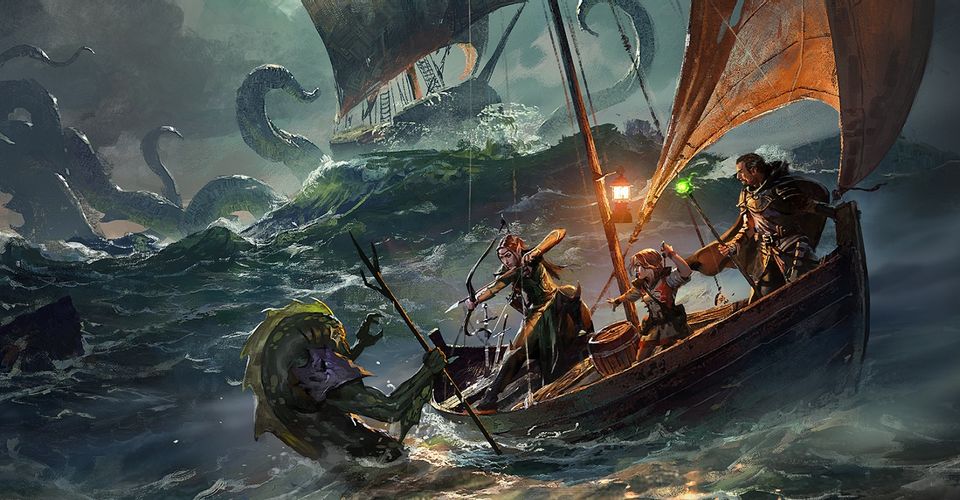How To Encourage D&D Party Bonding During Downtime

Adventures don’t just consist of epic battles in Dungeons & Dragons, they also consist of party bonding moments. Important plot points also unfold in locations like crowded taverns, sleepy inns, or even around a campfire. D&D is a roleplay-driven action-adventure game based on story-telling and focused on the group of adventurers taking on the challenges of the campaign. Because of this, party interaction and character growth are important factors in a successful campaign. However, it isn’t uncommon for the party to miss out on important bonding time due to numerous encounters and plot points happening close together. To avoid this, adding specific points of downtime during adventures can help encourage interaction.
While easier to prepare and plan for, stereotypically placed downtime can cause missed party interactions and story opportunities in Dungeons & Dragons campaigns. Often, the downtime is only briefly available before the party sleeps, or in locations like busy taverns. These spaces don’t always encourage party-centered interactions, as there are random NPCs to speak with and tasks to accomplish to be prepared after a long rest. However, there are numerous ways for D&D DMs to introduce pauses that are both engaging for the players, and useful to the story’s progression. These brief interludes allow party members to ask each other questions, build relationships, and learn important backstory information that could be useful at a later time in the campaign – in short, the fundamental elements of D&D party bonding.
While these pauses may seem tedious, especially in an action-driven Dungeons & Dragons campaign, allowing players the chance to interact outside of combat encourages better party dynamics, boosts the confidence of newer players, and builds emotional ties between player characters (and potentially players themselves). These interactions can be beneficial to the DM as well, giving insight into the emotional strengths and weaknesses of each character in the party. Below are some ideas for engaging downtime opportunities to encourage D&D party bonding.

Most Dungeons & Dragons campaigns take place in worlds that require some degree of travel to get from one plot point to the next. This could be travel from the rich part of a city to a run-down slum or from one kingdom to another across an entire continent. Instead of relying on combat as a time-filler, a DM could consider adding space for players to talk and bond as a party while on the road. While packing travel with random encounters can be a good way to level up between dungeons or boss fights, these combat sessions can also become repetitive and boring for the party over the course of repeated smaller battles.
This interaction time could be an opportunity for the DM to encourage the D&D party to engage on their own, or the time could be guided by the DM with the use of a discovery not related to combat. For example, the party could be a half day’s travel from their destination when they stumble upon an empty carriage on the road. The DM could set up the situation, and then let the players engage with each other to explore the carriage. There could also be a scenario where the DM points out that a player recognizes a certain plant or tree from their homeland, and encourage the party to ask about that character’s story, leading to party bonding. This kind of setup can be particularly helpful with new players who may be hesitant to engage in roleplay during a session.
D&D Party Bonding Often Happens Setting Up A Campsite

While the tavern is often overused as a D&D location to encourage character engagement, camping is a good alternative for DMs to consider for party bonding. Without alcohol on tap and NPCs to distract the party, setting up camp offers players the ability to engage in domestic activities together. It could be that a city-raised Cleric has never pitched a tent, and the Rogue of the group has to teach them. The party could put the Fighter in charge of dinner, only to find they burned it. These small interactions often give characters a chance to show unique and amusing qualities or offer certain characters in the party who may otherwise not engage regularly a chance to spend time together.
Camping is also a great time for Dungeons & Dragons characters to share their backstories. A character could use the fire-building technique taught to them by a parent or mentor, and explain the story while adding wood to the flames. While patching up the day’s scrapes and bruises, the healer of the group could tell a story about why they chose to learn healing arts instead of combat techniques. It could also be a time for the characters to reflect on their past struggles and triumphs, or discuss the dangers that lie ahead. This helps encourage in-character strategy building and brings the party bonding to new levels for their future adventures.
Shopping Trips Are Perfect Downtime For D&D Party Bonding

While shopping may seem like an odd time for party bonding, it can actually be a particularly humorous chance for interactions. Depending on the D&D class of each character, different shops will need to be visited to restock on needed items. For example, a Wizard and Fighter could become shopping partners, only for the Fighter to watch in mild horror as the Wizard purchases the odd components needed to prepare spells. A Cleric could decide to stop by the local church accompanied by the party’s Rogue to pray for safety on their next quest, only to be kicked out when the Rogue steals gold from the donation box. These interactions could boost relationships between characters or negatively impact the party, creating interesting inter-party dynamics at later points in the campaign.
Certain situations when shopping could also allow the DM to introduce side-quest plot hooks or puzzles for the party to solve. For example, getting kicked out of the church, the players could spot fresh mounds of earth behind the building away from the cemetery to investigate. Leaving a shop through a side door, players may notice a trap door underneath a pile of wooden crates. Because roleplay is the driving force of a Dungeons & Dragons campaign, the interactions happening during downtime can be the perfect opportunity to weave new ideas into the story, keeping the plot fresh and engaging for the party and the DM.
About The Author

















